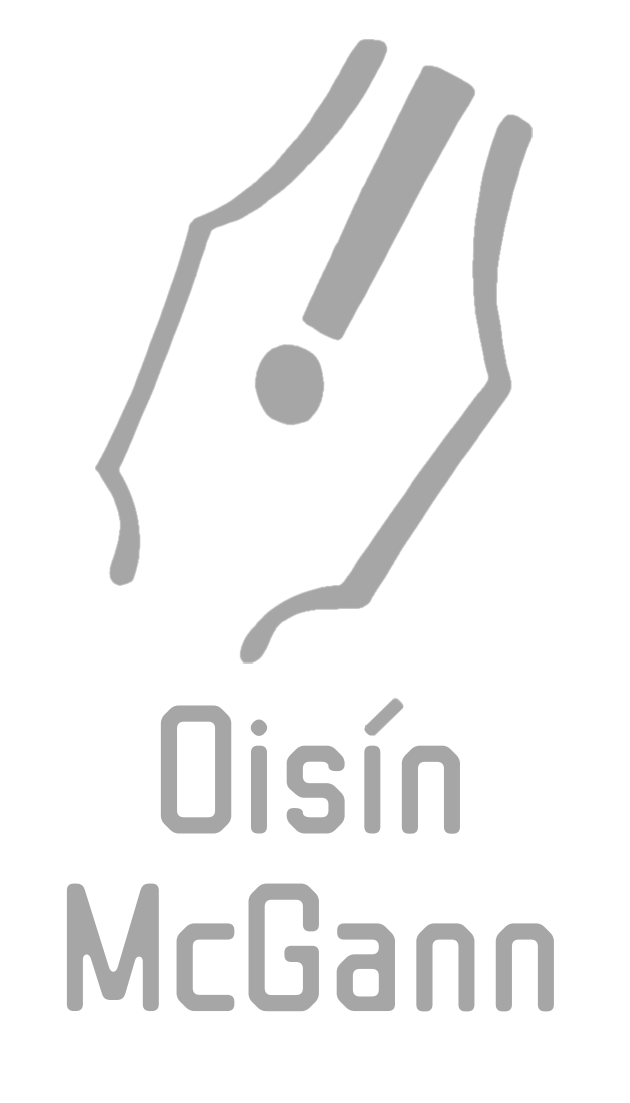It was a typical evening in our home. Our fifteen-year-old boy had just finished chasing his two little sisters around the house to get them good and wound up before bedtime. I was in the middle of explaining to our five-year-old why she couldn’t sleep in the cat’s bed, when our six-and-a-half-year-old (that half is very important), asked me:
‘When you stick up your middle finger, does that mean the F-word?’
If you’ve got kids, you’ll know that tricky questions can come at you out of nowhere. I suppressed the urge to laugh, partly because I didn’t want to make a big thing of this, but also because I want my kids to feel comfortable asking me questions and swearing is a serious business which everyone should learn to do properly. Apparently, she’d brought it up because it was the subject of some serious conversation in school. She goes to a small country school, where first and second class are in one room together, meaning you can have kids of six to nine all learning together, which is a pretty big gap in development. And not every lesson is being delivered by the teacher. 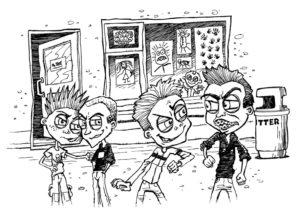 Particularly when the older ones have older brothers or sisters they’re learning from and then passing that knowledge on.
Particularly when the older ones have older brothers or sisters they’re learning from and then passing that knowledge on.
Swearing is a life skill, and when my girls grow up, I want to be sure they’re doing it with some fluency. As my father once solemnly told me, you have to save up your swearing for when you really need it, so it has the greatest effect. And he was a psychologist, so he knew what he was talking about. That said, I don’t feel swearing is a life skill that a six-and-a-half-year-old necessarily needs, so I didn’t try to explain that, at least when I was growing up, two fingers meant ‘Fuck Off’, while flipping the finger up at someone meant ‘Up Yours’ (a phrase that sadly seems to have fallen out of favour in recent times) and, in our area at least, we were pretty specific about the differences. This distinction is open to interpretation in various places around the world, but I settled for telling her that ‘No, it doesn’t normally mean the F-word, it means another rude word.’
‘What word?’
‘I’m not going to start teaching you how to swear yet, honey.’
I only realized after I’d said it, that I’d included the word ‘yet’. She remembers stuff like that.
‘The S-word is only a bit rude,’ our five-year-old added helpfully, as she continued to eye up the cat’s bed.
‘It is still pretty rude,’ I told her. ‘And I don’t want you using it.’
I was a bit late on this one, as she’d already used it a couple of times in the past (that I knew of), casually and in proper context. Fuck knows where they pick this shit up, but then having a little kid can be like having a walking voice recorder following you around. One that can play back key phrases when you’re all out in public. 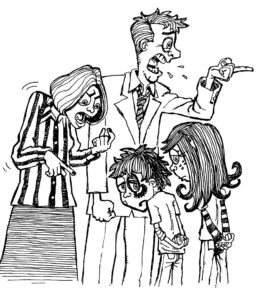 Anyway, there was our six-and-a-half-year-old in school, having conversations about swearing and it got me thinking about books (it doesn’t take much to get me thinking about books, but sometimes it’s actually relevant).
Anyway, there was our six-and-a-half-year-old in school, having conversations about swearing and it got me thinking about books (it doesn’t take much to get me thinking about books, but sometimes it’s actually relevant).
For a writer, dialogue is a vital way of defining your character. Each one should be distinctive and so, as in real life, they should speak in distinctive ways. When your characters cannot be permitted to swear, you’re hobbled in the ways you can have your characters expressing themselves, and it means it’s harder to reflect how people speak in real life.
If you work in children’s books, this is a restraint you accept. It comes with the job.
Sometimes, though, it feels like we’re applying just a bit too much restraint. This recent discussion with my daughter was further evidence of the fact that children’s books are perpetually behind the development of children when it comes to any area where parents’ inhibitions create an awkwardness and result in prohibition. We’re embarrassed to talk about it, so we ban any discussion of it. This, in turn, drives the child to seek their information on personal issues from other sources. Sources which can often be less than reliable.
Most of us teach our young kids not to swear. This is very natural, as we want them to use language appropriately and swearing can be unpleasant, disrespectful and, at times, very hurtful. We want to teach them to speak properly, to communicate well, before they venture into the murky world of foul language. If you write children’s books, this is one of the thorniest areas to navigate – the restraints are tight enough in Ireland and the UK, but look towards the US market and you have to cut back even further.
I write for different age groups and with different publishers, and standards vary slightly from company to company, even from editor to editor, but it is largely decided by what is considered acceptable in schools. And schools can tolerate very little in the way of bad language. For books aimed at primary school level, you’d be lucky to get away with terms like: ‘bloody’, ‘flippin”, ‘crap’, ‘damn’ or even the mildest blasphemy. 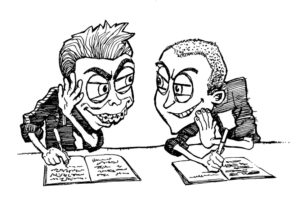 What can be accepted in the classroom comes down to an individual teacher’s judgement and they regard it as a practical issue; feature this language in books used in school and it’s feared the kids will start using it in class. And nobody wants kids swearing at teachers – that way lies educational armageddon. And children’s publishers want to sell into schools, ‘cos that’s a big part of their market. So the writers who work with those publishers willingly conform to those expectations.
What can be accepted in the classroom comes down to an individual teacher’s judgement and they regard it as a practical issue; feature this language in books used in school and it’s feared the kids will start using it in class. And nobody wants kids swearing at teachers – that way lies educational armageddon. And children’s publishers want to sell into schools, ‘cos that’s a big part of their market. So the writers who work with those publishers willingly conform to those expectations.
However.
I’d be delighted if books were the biggest influence on a child’s language. As with any subject that we are reluctant to broach with our kids, like nudity and sex, for example (which I’ve already written about), when we fail to provide the necessary information, children go looking for it elsewhere. They’re going to pick up stuff from other kids around them, and from us, their parents, of course, in those moments when we fail to censor our own language, but it doesn’t stop there.
Even with the best filters in the world (which we normally fail to apply), kids will pick up words on the web that would have us wincing in social anguish. Which is fair enough – I mean, hardly any of us learned our meatiest obscenities from reputable sources.
But their range of sources is infinitely wider than when most of us were young and what’s more, the stakes are far higher. Because once they get involved in social networks, they’re not just talking, they’re publishing. 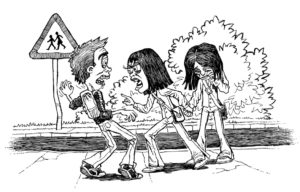 Everything they say is accessible to a potentially huge audience and could cause much greater hurt, offence or misunderstanding. And could be permanently on display.
Everything they say is accessible to a potentially huge audience and could cause much greater hurt, offence or misunderstanding. And could be permanently on display.
The range of influences on teenagers’ language, for instance, is enormous – and I think it’s making them more sophisticated as a result, both in terms of vocabulary and comprehension. They are more aware of the nuances of language, more conscious of how they use it, because they are exposed to so many people who use it well. But in terms of understanding the potential consequences of what they might say, most of them are way behind where they need to be. And given that media-savvy celebrities, politicians and other public figures are constantly being caught out and made to suffer for it, we can’t hope to train young people not to say stupid things online. I’m a forty-two-year-old professional writer, more conscious than most of the meaning of words, and I still spew more verbal shite than I’d like to admit.
Not here, obviously. These are pearls, I’m giving you here. Pearls, I tell ya.
Speech is still our primary form of expression, of communicating ideas – most of us still talk more than we read – though written words are now giving speech a run for its money, and our ever-present phones are blurring the difference between the two. The advantage of the written word used to be that we tended to think a bit more before we wrote. Now, with texts and social networks? Not so much. Those fingers can dump you in it every bit as fast as your mouth can. And those words can hang there, reaching one person after the next, long after we’ve stopped thinking about them. Unlike speech, they don’t evaporate the moment they’re created.
Which is why kids need to start learning, and learning early, the difference between expressive but relatively harmless swearwords, potentially hurtful insults and the kind of language that borders on a hate crime. And because this is often just a matter of degrees, of nuance and the character of the people who might hear or read it, it should be part of their education in communication. 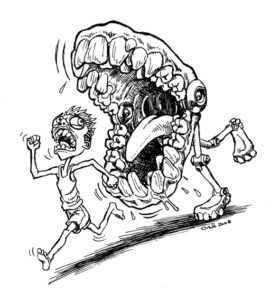 The best we can hope for, is that we give them decent foundations to work from, which is what the education system tries to do.
The best we can hope for, is that we give them decent foundations to work from, which is what the education system tries to do.
In fiction, we should be able to go a bit further. I have had a discussion with an editor about whether an unpleasant character should utter a racist comment. She had misgivings because . . . then there’d be a racist comment in the book – and this was in a novel, with ‘Unsuitable for Younger Readers’ printed on the back. The same has happened with a homophobic comment. It was only reflective of how that teenager would speak, but I had to argue to have it in. Never mind that that is the kind of language that a child will encounter in real life. Let’s be clear about this, I wasn’t using these terms as my voice in the narration; these were uttered by characters in scenes I was depicting, scenes that I wanted to make as realistic as possible. But we had to mull over whether they could be permitted or not.
In books for children in primary school, I can’t use language that any kid will hear yelled out at a football match. I can’t use the correct anatomical terms for intimate body parts most human beings have. I recently had to take the word ‘pee’ out of a story because it was feared it would cause a disruptively riotous case of the giggles if it was read out in class. Well, no wonder, if they’re never allowed say it. And yet every school has toilets that the students are using every day. But we have to be careful about mentioning what actually happens in these tiled sanctums. In another story, I had to remove a very inoffensive reference to reindeer shit too, for the same reason. Referring to doing a poo or a pee is most definitely not swearing, but it is put in the same category of language.
Even with older readers, those who are reading novels, but don’t quite count as ‘young adults’ yet, if we want to create a situation that illustrates what’s wrong with using the word ‘gay’ as an insult, as a synonym for ‘stupid’, ‘weak’, ‘pathetic’ or ‘uncool’ – as it is so often used – it sometimes feels like we have to sell it as a social issues story, not . . . y’know . . . just a story. This justifies the reference to it in a book. To feature the derogatory uses of the word, even while making it clear why they’re unpleasant, the story almost has to be about being gay.
We could, instead, just show the effect of this kind of abuse on a character our reader has developed some empathy for, as part of a story that’s about something else entirely. The same goes for terms that are racist, sexist, insulting to someone’s religion or bigoted and hurtful in other ways. But writers can’t differentiate between these harsh terms and comparatively harmless swearwords if we can’t use any of them in our stories.
We need to start making these distinctions as early as possible, using language that’s appropriate to the age of the child, rather than the conventions of the school system. By lumping this vast variety of terms into the same category, and banning the whole damn lot of them, we are giving up most of the influence we can have over how they’re used . . . and, a crucial point for the publishing industry, we’re making books seem less relevant to young people’s lives.
And yet it’s in books where this can be handled best. Books are quiet, private and deliberately exact in their language. They have time to be thoughtful, to offer context and can be digested at the reader’s own pace. They also have the advantage of only being accessible to a reader of the intended level or above. Reading is a natural form of filtering or certification. You can’t access the material inside if you’re not able to read it.
But by the time the kids are reading stories where we can explore these issues, they’ll have been wondering for years why nobody swears in books. And they will unconsciously attribute this absence to the suspicious relationship publishing has with the education system.
Fortunately, they don’t need books for this kind of thing, because they are busy surfing the web, as well as writing to and for each other, and they can take delight in being as colourful, expressive and offensive as they like – using terms they can learn and share across ever-expanding networks.
Language is as powerful as it is delicate. It can soothe an upset child or it can convince a nation to go to war. Where swearing is concerned, I think children’s books need to take the gloves off earlier, to play and examine and explore foul language. To relish the imaginative insult and wallow in lyrical profanity. But because of the nature of the beast, it also must be dealt with in context, handled with sensitivity and tact. It can’t be a matter of just throwing more swearwords into books – the usual problems will immediately limit our audience: the books won’t get distribution because publishers will be concerned about the reaction of schools and libraries. Schools and libraries will be concerned about the reactions of parents.
It is not the professionals in the book world who need the most convincing. In my experience, the vast majority of these people are pretty open-minded, liberal types, who just want to see kids reading books. When dealing with children, the pace of change is often set by the most reactionary parent, the one who will express outrage and threaten consequences for those who have tainted the soul of their child. You can’t be seen to be leading people’s kids astray.
And much as I’d like to say ‘Ah, fuck ’em!’, it doesn’t work like that.
Publishers run on tight margins. Even if you were to say we’d only try and sell it through shops, and let each parent decide what they’ll let their kids read, that’s too big a cut in potential sales for most publishers to take.
Short of running a massive advertising campaign aimed at convincing parents to let us use more offensive language in children’s books, it’s hard to see what to do. It’s all to easy to fall back onto bland words that lack impact and sound unconvincing. 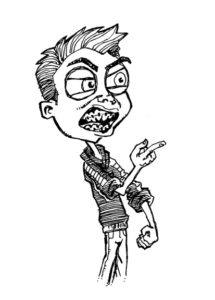 But as writers, we can start pushing more, stretching those elastic boundaries, consciously searching out spiky terms, earthier language, entertaining insults and killer put-downs. If we can’t get some established term past the filters, find another one, a great sounding one, that does the same job. It’s the kind of thing writers do anyway. And we need to start early.
But as writers, we can start pushing more, stretching those elastic boundaries, consciously searching out spiky terms, earthier language, entertaining insults and killer put-downs. If we can’t get some established term past the filters, find another one, a great sounding one, that does the same job. It’s the kind of thing writers do anyway. And we need to start early.
We can make bad language a topic of conversation, as well as just an embellishment, so that it’s harder to remove it in the editing process. We can use dialogue with deliberate intent; have our characters interrogate meaning – like my six-and-half-year-old is already doing in school with her friends – argue about swearwords, make jokes about them, ask questions about them, wonder why weak ones don’t work, why misplaced ones are funny, what ones you can or can’t use in front of parents or teachers.
Demonstrate how a child’s language changes when there is no authority figure around, because it does. Make fun of the contortions parents go into trying not to swear in front of their children. Make us laugh at the innocent questions young kids ask about what they hear.
Pose the questions in stories that we want children to ask themselves about the language they use and how they use it. About what it means, how it sounds. About the effects it can have. This is a tricky thing to do, and it’s important and expressive and it’s fun and those are the best reasons to write anything.
In conclusion, we need to start sneaking more bad language in children’s books. Spread the word.
